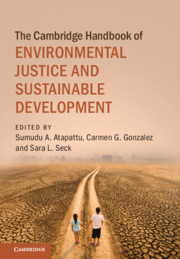Book contents
- The Cambridge Handbook of Environmental Justice and Sustainable Development
- The Cambridge Handbook of Environmental Justice and Sustainable Development
- Copyright page
- Contents
- Contributors
- Acknowledgments
- Foreword (on Living in an Interregnum)
- 1 Intersections of Environmental Justice and Sustainable Development
- Part I Frameworks
- Part II Case Studies
- Strategies, Challenges, and Vulnerable Groups
- Toxic Substances and Hazardous Wastes
- Resource Extraction
- Energy
- Climate Change
- 26 Climate Justice and the Social Pillar in California’s Climate Policies
- 27 Climate Change–Related Ecohealth Considerations for Impact Assessments in the Canadian Arctic
- 28 Climate Justice, Sustainable Development, and Small Island States
- Part III Conclusion
- Index
26 - Climate Justice and the Social Pillar in California’s Climate Policies
from Climate Change
Published online by Cambridge University Press: 26 March 2021
- The Cambridge Handbook of Environmental Justice and Sustainable Development
- The Cambridge Handbook of Environmental Justice and Sustainable Development
- Copyright page
- Contents
- Contributors
- Acknowledgments
- Foreword (on Living in an Interregnum)
- 1 Intersections of Environmental Justice and Sustainable Development
- Part I Frameworks
- Part II Case Studies
- Strategies, Challenges, and Vulnerable Groups
- Toxic Substances and Hazardous Wastes
- Resource Extraction
- Energy
- Climate Change
- 26 Climate Justice and the Social Pillar in California’s Climate Policies
- 27 Climate Change–Related Ecohealth Considerations for Impact Assessments in the Canadian Arctic
- 28 Climate Justice, Sustainable Development, and Small Island States
- Part III Conclusion
- Index
Summary
As California legislators first contemplated comprehensive climate action in the early 2000s, environmental justice activists recognized the connection between climate policy and the everyday challenges faced by the state’s poorest and most vulnerable residents. They understood the urgency of climate action because their communities were likely to be the least able to cope with impending climate impacts, like sea level rise, heat waves, and wildfires. And they understood that efforts to reduce greenhouse gases (GHGs) could accomplish multiple goals, including reducing the persistent air pollution plaguing many parts of California.
- Type
- Chapter
- Information
- Publisher: Cambridge University PressPrint publication year: 2021

